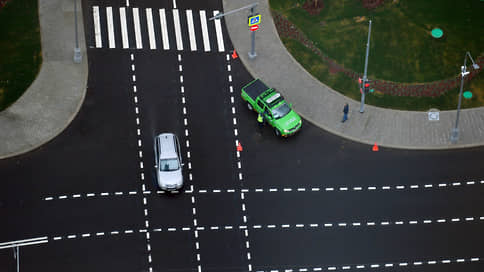The capital’s data center and traffic police now record a ban on parking on the “guide island”
[ad_1]

The capital’s data center and traffic police are now recording a new offense – parking on the so-called guide island, indicated by markings on the roadway. The fine for parking on it is 2.5 thousand rubles, the first “letters of happiness” are already being sent out in Moscow. As part of the “pilot”, one camera is currently operating in Lefortovo, but perhaps soon there will be more such automatic systems.
The Moscow Traffic Management Center (Moscow Traffic Management Center) and the State Traffic Safety Inspectorate have begun recording and administering the new offense, the press service of the Moscow Traffic Safety Inspectorate told Kommersant. It’s about prohibition of parking on the “guide island” (located at the same level with the roadway or a road element raised above it to separate and merge traffic flows.). The camera records the vehicle entering the island and gives the driver 5 minutes. After this, a resolution is formed under Part 5 of Art. 12.19 of the Code of Administrative Offenses (fine 2.5 thousand rubles), which is transferred to the traffic police. So far, only one automatic complex works this way on the Academician Tupolev embankment (Lefortovo).
The concept of “guide island” has been introduced into the traffic rules since March 1, 2023. Most often, such islands are a triangular zone marked with markings and diagonal stripes, located at an intersection or on an exit where parking is not allowed. Sometimes concrete blocks, small architectural forms, etc. are placed inside the islands.
Parking on an island often causes accidents, since abandoned cars limit the view of other drivers, the data center told Kommersant.
“The complex put into operation in Lefortovo is not experimental; its use has been approved by the State Traffic Inspectorate,” the center clarified. “If necessary, such cameras will be used in other problem areas.” It should be noted that the number of islands in the city increases every year as traffic management and re-marking projects are implemented.
The head of the expert center Probok.net, Alexander Shumsky, supports the actions of the data center and the traffic police, but calls on the authorities to take into account all the circumstances of the violation: “After all, islands can help out in the event of a vehicle breakdown or some kind of emergency situation. It is important that in such cases fines do not come.” An expert on violation detection systems, Grigory Shukhman, supports him: in certain life situations, drivers are forced to drive onto an island to avoid an accident, during road work, and stand there for more than five minutes. The software may perceive this as a violation. Similar cases have already occurred in 2021, when drivers, finding themselves in the right lane during heavy traffic jams, received fines from stationary complexes for allegedly parking in a prohibited place. Mr. Shumsky also recalls precedents when drivers stopped on the side of the road (this is allowed), but the moment of leaving the road was considered by the camera to be driving on the side of the road, and the traffic police sent a fine.
The location where the island is used does not allow it to be confused with a parking lot and stop accidentally, Kommersant was assured by the data center.
“During the initial processing of materials from the complexes, data processing center employees check the actual condition of the roadway,” explained the center. “If the markings are partially or completely not visible, then the material is transferred to the traffic police with a special mark. The inspector makes a decision on whether to prosecute. In the event of an emergency, if traffic is organized according to a temporary pattern, through a guide island, fines are not issued.”
This is the second “new” set of violations that the capital’s cameras began recording this year: in January, a camera was installed on Svoboda Street, recording cars that do not stop near the tram stop. This type of administration is also associated with a new ban introduced on March 1, 2023: if at a stop in front of a car a tram stops with the sign “Attention, passenger!” (or the silhouette of a passenger on the board), you need to let passengers through and wait until the board goes out.
[ad_2]
Source link








